Commands: emegs3d
Contents:
to start creating 3d plots in emegs, a dataset must be loaded using
emegs2d. Then push the emegs3d-button
to open the 3d console. To create the default plot type with all
default settings, simply hit the apply button on the bottom left of
emegs3d-console. This will produce a plot like the one shown below:
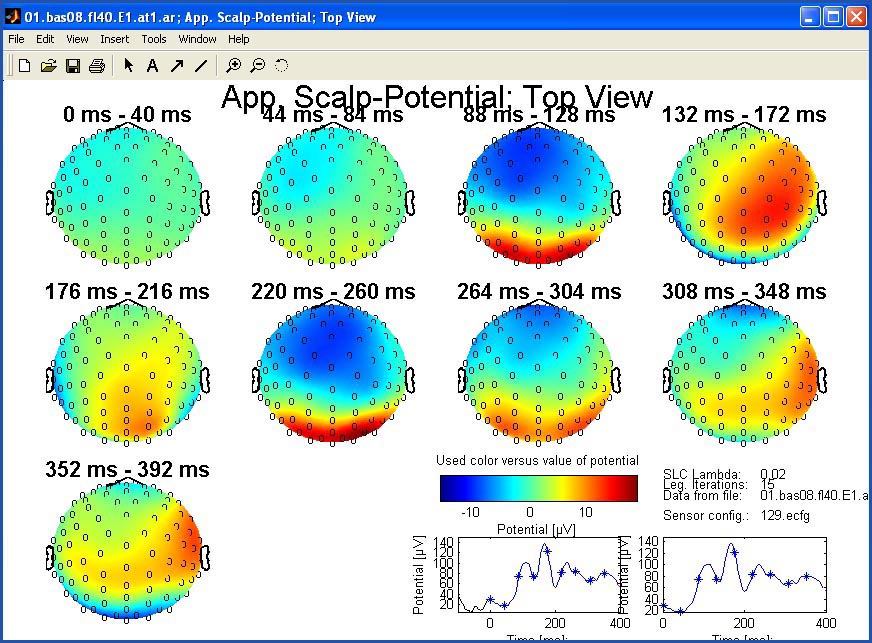 |
| Figure 1: the default plot type
of emegs3d: >>Plot2d<< layout, >>Sphere<<
headmodel, >>autoscaled<<, with sensor positions indicated
on all intervals, using 256 colors of the jet colormap, blue colors
indicating low and red colors high amplitudes. |
plot types: emegs has 6 different
plot layouts, that you can set using the Surf View- dropdownlist on the
emegs3d-console: Spec. Surf. ,
All Surf I , All Surf II, Plot2d, Head View and Cols & Rows.
 |
| |
| Figure 2: Surf View, Head View
and Render Model controls |
Spec. Surf. , All Surf I , All Surf II and Head View will print only one time point, Plot2d and Cols & Rows display an interval
sequence. Spec. Surf. , All Surf I , All Surf II will give additional
views and information, Head View
shows only the surface model with an amplitude colorbar.This sequence
is taken from the emegs3d-console as described
at ![]() interval settings.
[
interval settings.
[![]() Top]
Top]
| Spec. Surf. |
|
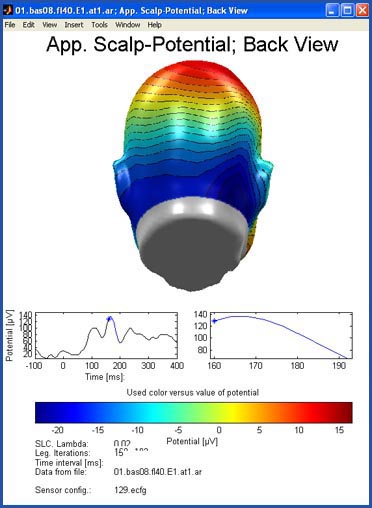 |
| All Surf I |  |
|
| All Surf II |  |
|
| Plot2d | 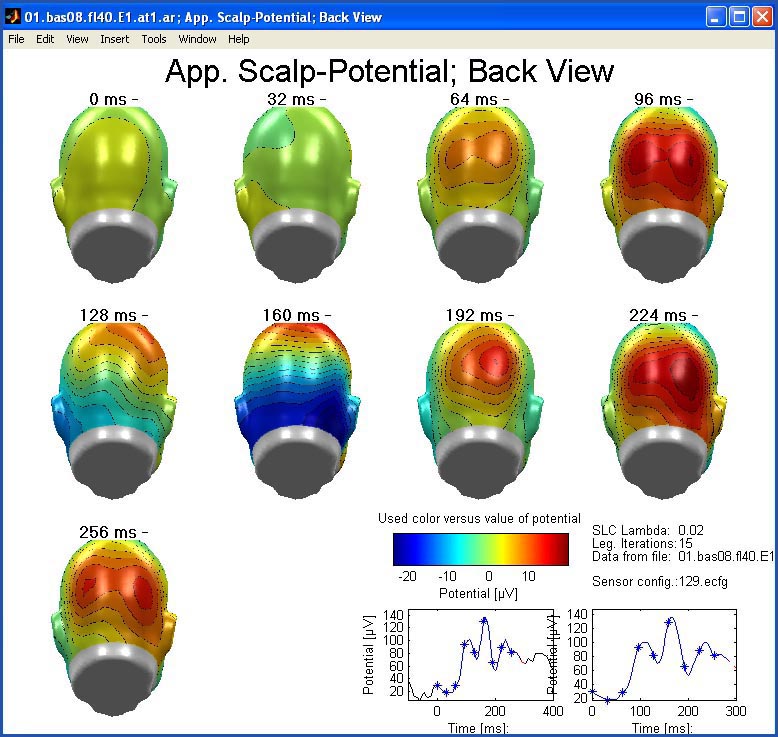 |
|
| HeadView | 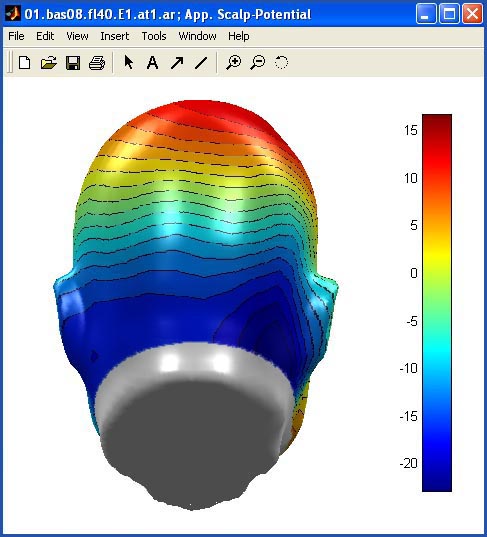 |
|
| Cols&Rows |  |
|
| Figure
3: plot layouts, set using the Surf View dropdownlist. |
||
head orientation: you
can select the initial position of the camera relative to the headmodel
using the Head View -
dropdownlist on the emegs3d-console. Some head models can later be
turned to see a different side, but not all. If the six options (top,
bottom, left, right, front, back) are too rough, you can use the theta
and phi edit boxes to enter azimuth and elevation angles
parametrically. Note that these angles are standard matlab spherical
coordinates, unlike the sensor coordinates used by emegs.
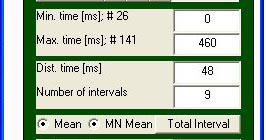 |
| |
| Figure 4: Min. time, Max. time,
Dist. time, Number of intervals, Total Interval and Mean/MN Mean
controls |
interval settings: interval
definitions on the emegs3d-console are set using the controls shown
above: the time range from Min. time
[ms] to Max. time [ms]
is divided into Number of intervals
segments, that each are of length Dist.
time [ms]. You can change any of these values, and emegs will
try to adjust the others accordingly. If a segment covers more
than 1 datapoint, the plotted data is calculated as average over the
points of the segment, as indicated by the Mean - radiobutton. If this button
is not activated, not the average is taken, but simple the first data
point in the segment. To cover the total available interval with
segments of mimimum duration and thus avoid any averaging, you can use
the Total Interval -
button. [![]() Top]
Top]
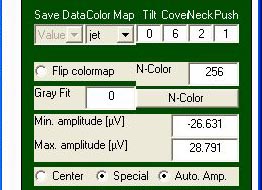 |
| |
| Figure 5: Color Map, Flip
colormap, N-Color, Min. amplitude, Max. amplitude, Center, Special and
Auto. Amp. controls |
amplitude scaling: the
default behavior of emegs is to scale each plot automatically in such a
way, that the entire range of colors of the present colormap are
used. This is indicated by the Auto.
Amp. - radiobutton, which should be deactivated, if you wish to
set the color limits manually with the Min.
amplitude - and Max. amplitude
- editboxes. The autoscaling is in fact often misleading, as event the
smallest differences will be scaled to cover the entire range of
available colors. When comparing experimental conditions, it is
therefore advisable to first create a plot using the autoscaling to get
a realistic scaling range, but then to deactivate it when creating plot
for the different conditions.
Jet is the standard colormap
of emegs, thus low amplitudes will be colored in blue, high amplitudes
in red, but you can change the colormap type by selecting a differnt
matlab color map in the Color Map-
dropdownlist. You can change the orientation of the colormap using the Flip colormap - radiobutton and set
the colormap resolution using the N-Color
-editbox. Low resolution will result in areas of the same color,
whereas high resolution will result in smooth color gradients. [![]() Top]
Top]
render models: emegs offers a
number of surface models, that evoked brain activity signal can be
projected on. Examples of each are given below using the HeadView plot layout seen from the
left side. Please note, that no inference about brain activity is
made with any model. All models are simply surface models, that a given
evoked activity is mapped on. This activity can be dipole activity, but
does not have to be - although the brain models obviously are meant for
diplaying dipole activations. To make estimations about generating
brain areas, see the ![]() source localization &
synthetic data - section. [
source localization &
synthetic data - section. [![]() Top]
Top]
| Sphere | 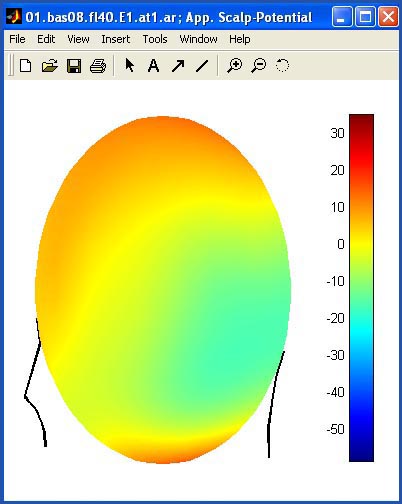 |
Head | 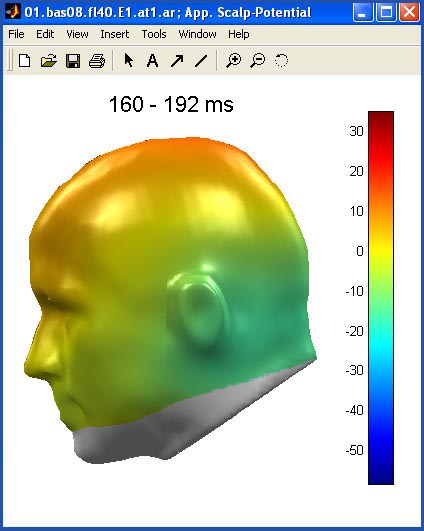 |
||
| Head
Smooth |
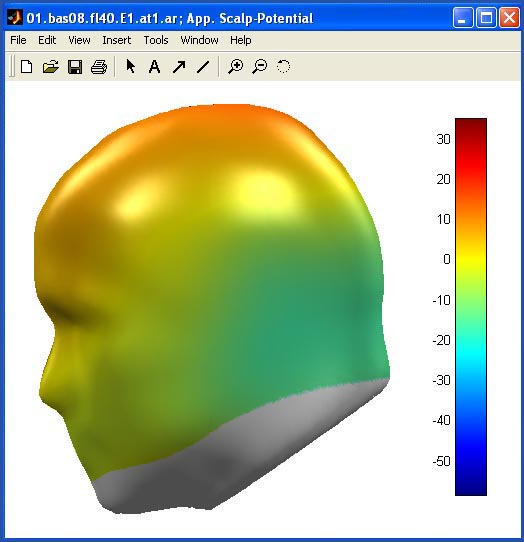 |
Brain | 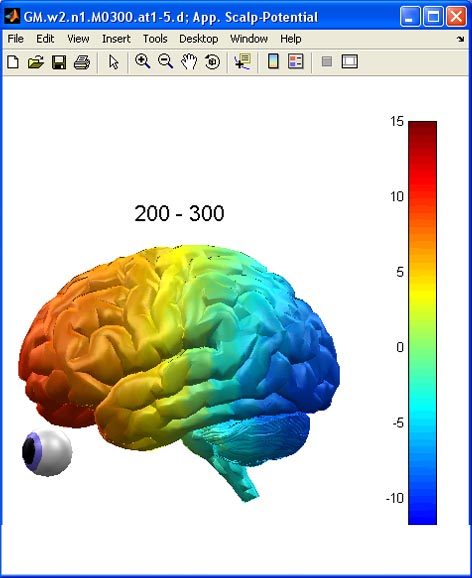 |
||
| Brain Low Smoothing | 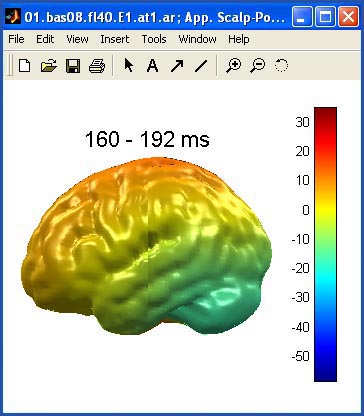 |
Brain High Smoothing | 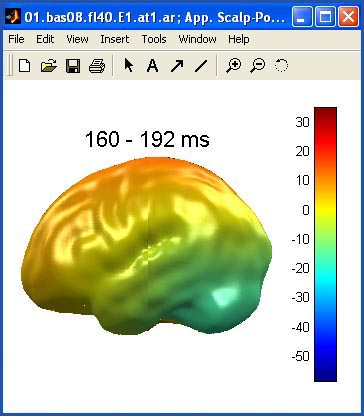 |
||
| BrainNC Low Smoothing | 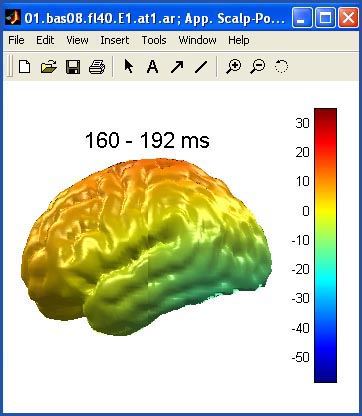 |
BrainNC High Smoothing |  |
||
|
|
|||||
| Head Neck | 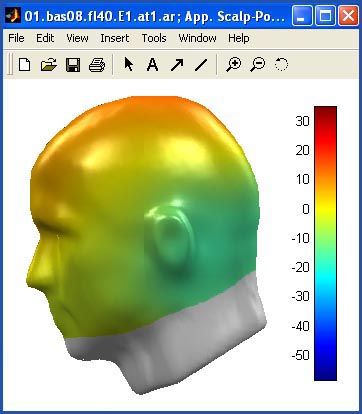 |
Head
Vol (enhanced contour line rendering) |
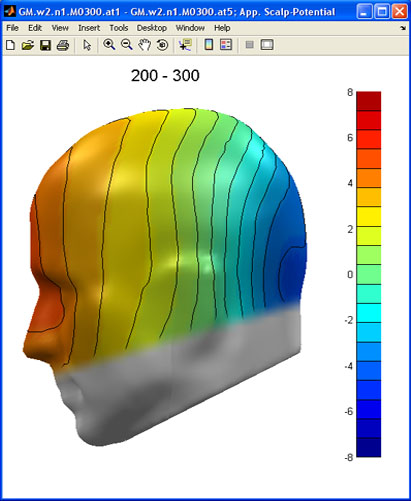 |
||
| BrainVol (enhanced contour line rendering) |
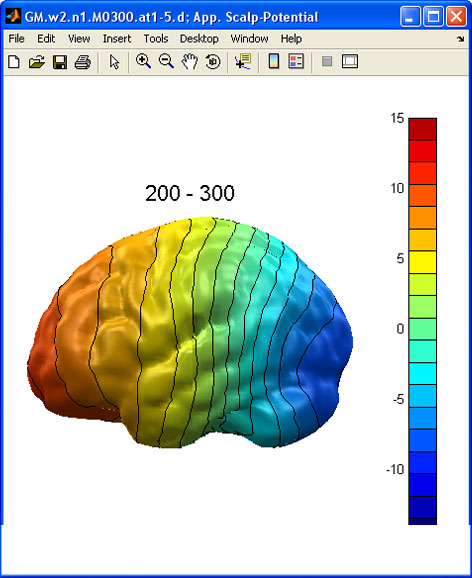 |
BrainNCVol (enhanced contour line rendering) |
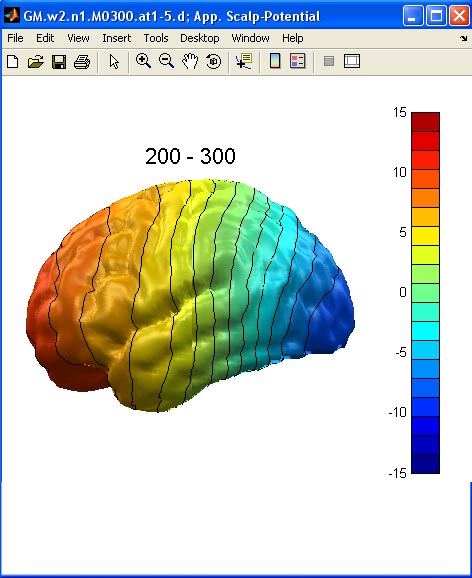 |
||
| Brain (HighRes) |
 |
||||
| Figure
6: Render models, set using the Render model control. |
|||||
texture mapping: the
render models head, head smooth, brain low smoothing, brain high
smoothing, brainnc low smoothing, brainnc high smoothing and head neck
employ texture mapping to display the signal topography on the render
model. This means that first a jpg image file is created (the texture,
saved in .../emegs2.1/contourplottmp.jpg) which is then pulled like a
glove over (mapped to) the headmodel:. You can influence this mapping
using the Tilt, Cover, Neck and Push editboxes shown in figure 5.
The effect of each is shown on the examples below: Tilt will rotate the potential map
around the X-Axis (see sensor cofigurations), positive values forward,
negative values backward. Be sure to activate leadfield recalculation
for every plot if you change the Tilt
value. Cover will
cover increasing amount of the potential map with white pixels, hiding
the original colors. Neck selectively
covers area on the back, leaving the front part unchanged. Push adds additional white area on
the bottom, pushing the potential map higher, without hiding any parts
of it. [![]() Top]
Top]

 |
| |
| Figure 7: Sensors, Contour,
Latency & PotCont controls |
contour lines: some of the
shown render models offer the possibilty to display activity as a
smooth color gradients or as contoured areas of the same color. This is
done using the PotCont-
dropdownlist. Using the head model, the contour options are illustrated
in the following table: [![]() Top]
Top]
| Smooth
|
|
Contour |
WContour |
2Contour |
2WContour |
|||
| |
||||||||
 |
|
 |
|
 |
|
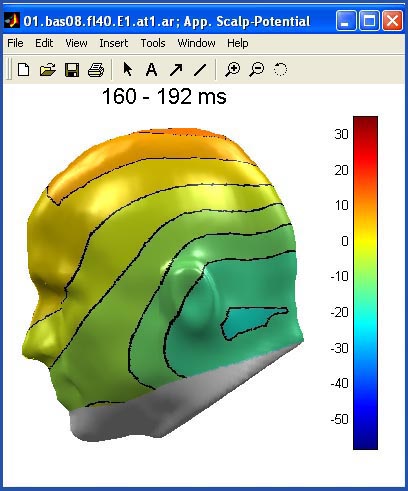 |
|
 |
| Figure
8: contour line options, set using the PoCont control. |
||||||||
sensor type, color and size:
sensor position markers
can be activated using the Sensors- dropdownlist. For a sequence, this
can be done only for the first plot in the sequence or for all
intervals. The marker type can be set using emegs3d-style-menu: as
text, on the texture or as cylinder. The three types are
illustrated below (click to enlarge). As the activity for the here used
'Head' render model is mapped
as a texture, the texture type is the precicest concerning it's
correspondence with the activity. For this render model, the texture
type should be used to check wether the texture position, the neck
coverage and the texture size is adequate for your sensor
configuration. The cylinder sensor type can be adjusted in color and
object size using the emegs3d-style-menu (\Style\Sensor size and
\Style\Sensor color). [![]() Top]
Top]
| Text |
|
Texture |
Cylinder |
|
| |
||||
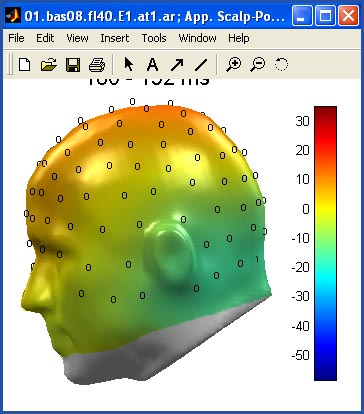 |
|
 |
|
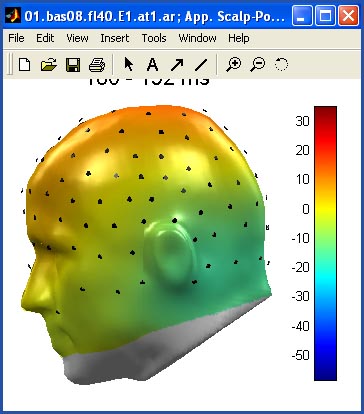 |
| Figure
8: contour line options, set using the PoCont control. |
||||
latency: latency information
can be activated using the Latency- dropdownlist. For a sequence, this
can be done only for the first plot in the sequence or for all
intervals. [![]() Top]
Top]
sphere model head shape:
Although artificial in appearance, the sphere
model is closest to the actual data and all 3d projections are
calculated based on the spherical head
model. However, with only the sphere visible, it is hard to distinguish
left from right and front from back. This is made a lot easier when
additional shapes are displayed for the nose, the ears and the neck.
The default setting is that these are displayed as line plots, but you
can select also a 3d contour type from the Contour-dropdownlist shown in figure
7.You can select the transparency of this 3d object using the
emegs3d-style menu (\Style\3d contour alpha\). Samples of line
and 3d contours are given below. [![]() Top]
Top]
| line
contour |
|
3d
contour (alpha = 1) |
3d
contour (alpha = 0.2) |
|
| |
||||
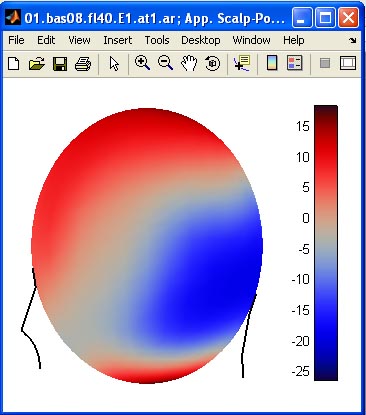 |
|
 |
|
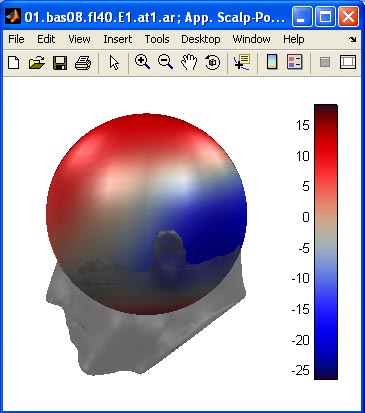 |
| Figure
8: head shape options, set using the Contour control. |
||||